Electric FORD KUGA 2011 1.G Workshop Manual
[x] Cancel search | Manufacturer: FORD, Model Year: 2011, Model line: KUGA, Model: FORD KUGA 2011 1.GPages: 2057
Page 6 of 2057
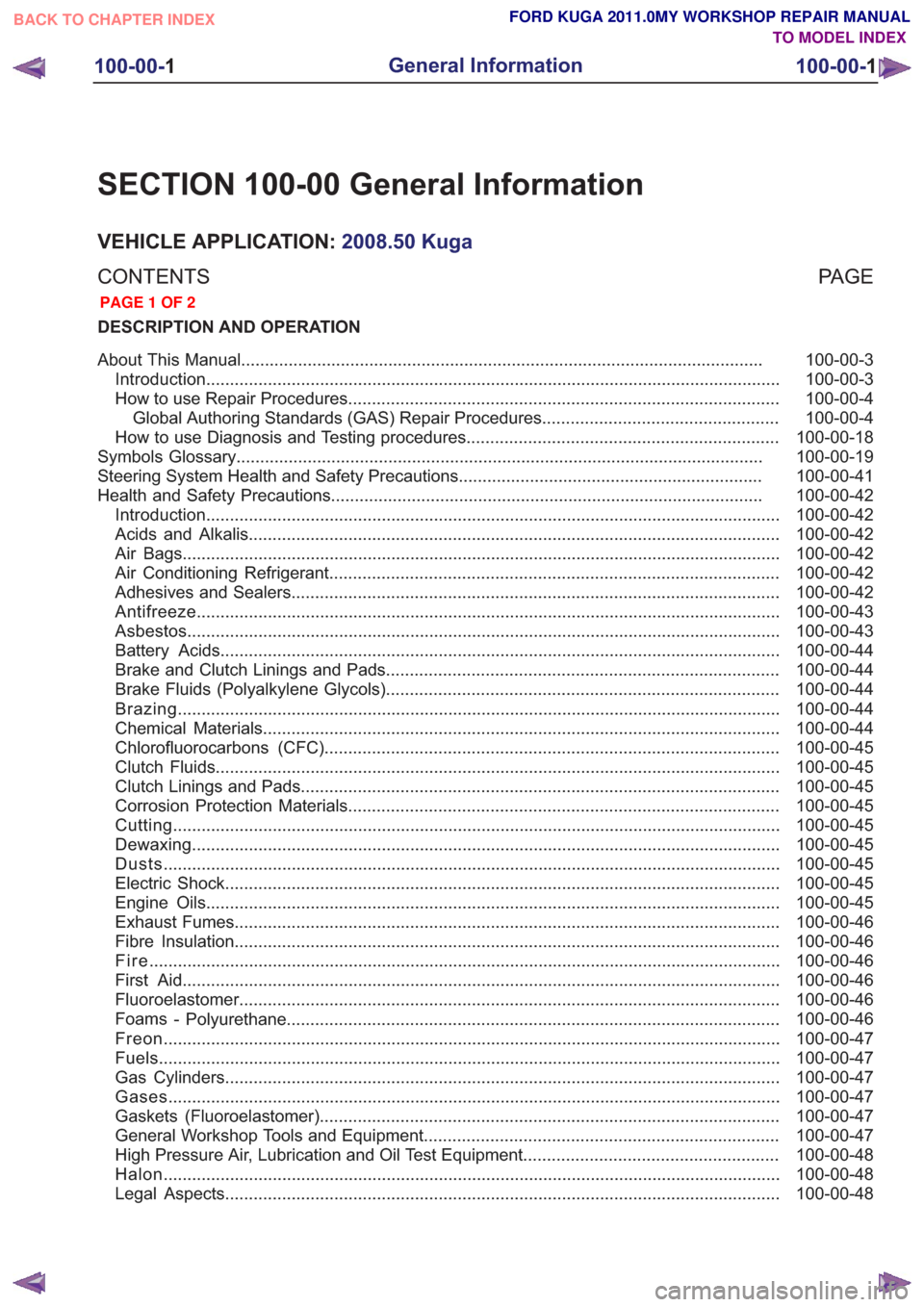
SECTION 100-00 General Information
VEHICLE APPLICATION:2008.50 Kuga
PA G E
CONTENTS
DESCRIPTION AND OPERATION
100-00-3
About This Manual ........................................................................\
......................................
100-00-3
Introduction ........................................................................\
.................................................
100-00-4
How to use Repair Procedures ........................................................................\
...................
100-00-4
Global Authoring Standards (GAS) Repair Procedures ..................................................
100-00-18
How to use Diagnosis and Testing procedures ..................................................................
100-00-19
Symbols Glossary ........................................................................\
.......................................
100-00-41
Steering System Health and Safety Precautions ................................................................
100-00-42
Health and Safety Precautions ........................................................................\
...................
100-00-42
Introduction ........................................................................\
.................................................
100-00-42
Acids and Alkalis ........................................................................\
........................................
100-00-42
Air Bags ........................................................................\
......................................................
100-00-42
Air Conditioning Refrigerant ........................................................................\
.......................
100-00-42
Adhesives and Sealers ........................................................................\
...............................
100-00-43
Antifreeze ........................................................................\
...................................................
100-00-43
Asbestos ........................................................................\
.....................................................
100-00-44
Battery Acids ........................................................................\
..............................................
100-00-44
Brake and Clutch Linings and Pads ........................................................................\
...........
100-00-44
Brake Fluids (Polyalkylene Glycols) ........................................................................\
...........
100-00-44
Brazing ........................................................................\
.......................................................
100-00-44
Chemical Materials ........................................................................\
.....................................
100-00-45
Chlorofluorocarbons (CFC) ........................................................................\
........................
100-00-45
Clutch Fluids ........................................................................\
...............................................
100-00-45
Clutch Linings and Pads ........................................................................\
.............................
100-00-45
Corrosion Protection Materials ........................................................................\
...................
100-00-45
Cutting ........................................................................\
....................................................... .
100-00-45
Dewaxing ........................................................................\
....................................................
100-00-45
Dusts ........................................................................\
..........................................................
100-00-45
Electric Shock ........................................................................\
.............................................
100-00-45
Engine Oils ........................................................................\
.................................................
100-00-46
Exhaust Fumes ........................................................................\
...........................................
100-00-46
Fibre Insulation ........................................................................\
...........................................
100-00-46
Fire ........................................................................\
.............................................................
100-00-46
First Aid
........................................................................\
......................................................
100-00-46
Fluoroelastomer ........................................................................\
..........................................
100-00-46
Foams
- Polyurethane ........................................................................\
................................
100-00-47
Freon ........................................................................\
..........................................................
100-00-47
Fuels ........................................................................\
...........................................................
100-00-47
Gas Cylinders ........................................................................\
.............................................
100-00-47
Gases ........................................................................\
.........................................................
100-00-47
Gaskets (Fluoroelastomer) ........................................................................\
.........................
100-00-47
General Workshop Tools and Equipment ........................................................................\
...
100-00-48
High Pressure Air, Lubrication and Oil Test Equipment ......................................................
100-00-48
Halon ........................................................................\
..........................................................
100-00-48
Legal Aspects ........................................................................\
.............................................
100-00-1
General Information
100-00- 1
.
TO MODEL INDEX
BACK TO CHAPTER INDEX
PAGE 1 OF 2 FORD KUGA 2011.0MY WORKSHOP REPAIR MANUAL
Page 8 of 2057
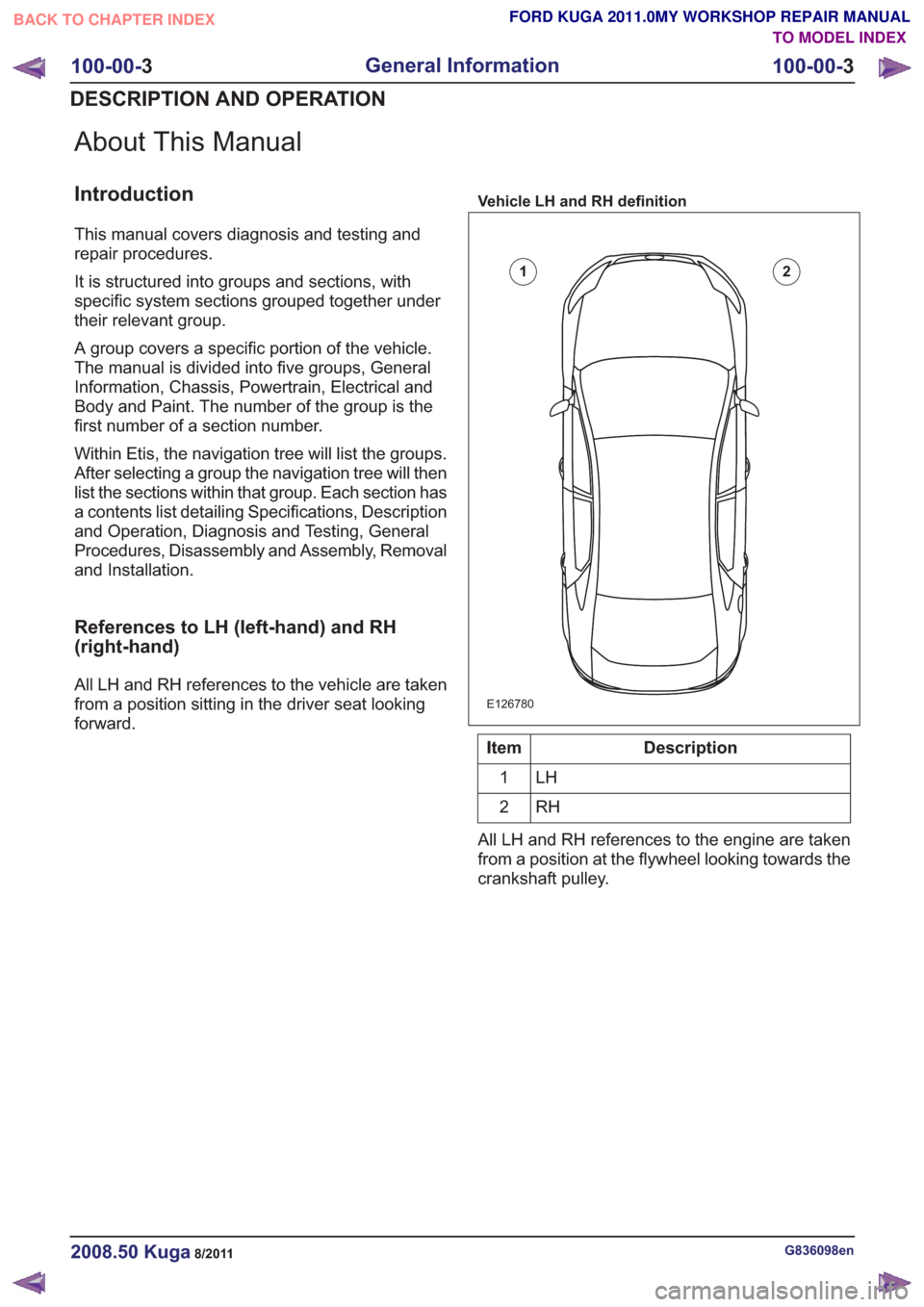
About This Manual
Introduction
This manual covers diagnosis and testing and
repair procedures.
It is structured into groups and sections, with
specific system sections grouped together under
their relevant group.
A group covers a specific portion of the vehicle.
The manual is divided into five groups, General
Information, Chassis, Powertrain, Electrical and
Body and Paint. The number of the group is the
first number of a section number.
Within Etis, the navigation tree will list the groups.
After selecting a group the navigation tree will then
list the sections within that group. Each section has
a contents list detailing Specifications, Description
and Operation, Diagnosis and Testing, General
Procedures, Disassembly and Assembly, Removal
and Installation.
References to LH (left-hand) and RH
(right-hand)
All LH and RH references to the vehicle are taken
from a position sitting in the driver seat looking
forward.
Vehicle LH and RH definition
E126780
12
Description
Item
LH
1
RH
2
All LH and RH references to the engine are taken
from a position at the flywheel looking towards the
crankshaft pulley.
G836098en2008.50 Kuga8/2011
100-00- 3
General Information
100-00- 3
DESCRIPTION AND OPERATION
TO MODEL INDEX
BACK TO CHAPTER INDEX
FORD KUGA 2011.0MY WORKSHOP REPAIR MANUAL
Page 9 of 2057
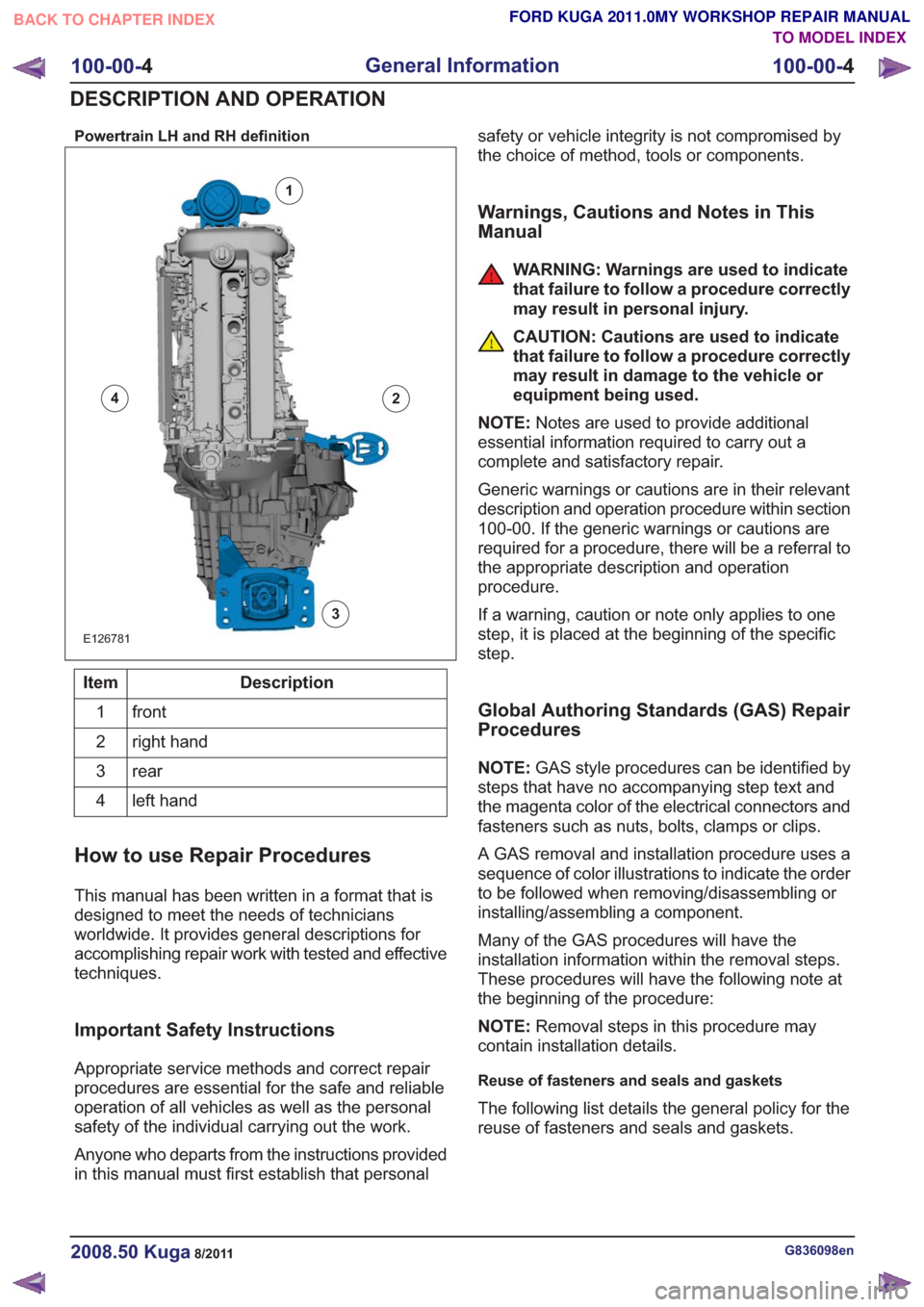
Powertrain LH and RH definition
E126781
1
2
3
4
Description
Item
front
1
right hand
2
rear
3
left hand
4
How to use Repair Procedures
This manual has been written in a format that is
designed to meet the needs of technicians
worldwide. It provides general descriptions for
accomplishing repair work with tested and effective
techniques.
Important Safety Instructions
Appropriate service methods and correct repair
procedures are essential for the safe and reliable
operation of all vehicles as well as the personal
safety of the individual carrying out the work.
Anyone who departs from the instructions provided
in this manual must first establish that personal safety or vehicle integrity is not compromised by
the choice of method, tools or components.
Warnings, Cautions and Notes in This
Manual
WARNING: Warnings are used to indicate
that failure to follow a procedure correctly
may result in personal injury.
CAUTION: Cautions are used to indicate
that failure to follow a procedure correctly
may result in damage to the vehicle or
equipment being used.
NOTE: Notes are used to provide additional
essential information required to carry out a
complete and satisfactory repair.
Generic warnings or cautions are in their relevant
description and operation procedure within section
100-00. If the generic warnings or cautions are
required for a procedure, there will be a referral to
the appropriate description and operation
procedure.
If a warning, caution or note only applies to one
step, it is placed at the beginning of the specific
step.
Global Authoring Standards (GAS) Repair
Procedures
NOTE: GAS style procedures can be identified by
steps that have no accompanying step text and
the magenta color of the electrical connectors and
fasteners such as nuts, bolts, clamps or clips.
A GAS removal and installation procedure uses a
sequence of color illustrations to indicate the order
to be followed when removing/disassembling or
installing/assembling a component.
Many of the GAS procedures will have the
installation information within the removal steps.
These procedures will have the following note at
the beginning of the procedure:
NOTE: Removal steps in this procedure may
contain installation details.
Reuse of fasteners and seals and gaskets
The following list details the general policy for the
reuse of fasteners and seals and gaskets.
G836098en2008.50 Kuga8/2011
100-00- 4
General Information
100-00- 4
DESCRIPTION AND OPERATION
TO MODEL INDEX
BACK TO CHAPTER INDEX
FORD KUGA 2011.0MY WORKSHOP REPAIR MANUAL
Page 11 of 2057

numerically in a graphic and the corresponding text
will be numbered accordingly.
Special Tools, Equipment, Materials and Torque
Figures
Special tools will be shown with the tool numbers
in the illustration. The special tool numbers, general
equipment, materials and torque figures used for
the procedure step will be shown in the text
column.
GAS Graphics
NOTE:Colors used in the graphic are as follows:
4
6
5
14
2
36
5
E141161
Description
Item
Blue - Target or primary component to be
removed/installed (or
disassembled/assembled).
1
Green - Components that need to be
removed prior to or installed after the
target/primary.
2
Description
Item
Brown - Components that need to be
removed prior to or installed after the
target/primary.
3
Yellow - Components to be set aside only,
that remains in the vehicle. Also
highlighted areas to inspect or adjust.
4
Magenta - Electrical connectors and
fasteners such as nuts, bolts, clamps, or
5
clips to be: detached, attached, loosened,
moved, removed or installed.
Pale Blue - Special tool(s), general
equipment, or common tools (used in an
uncommon way).
6
One illustration may have multiple steps assigned
to it.
Numbered pointers are used to indicate the number
of electrical connectors and fasteners such as nuts,
bolts, clamps and clips.
Items in the illustration can be transparent or use
cutouts to show hidden details.
E132042
x2
1
2
3
G836098en2008.50 Kuga8/2011
100-00- 6
General Information
100-00- 6
DESCRIPTION AND OPERATION
TO MODEL INDEX
BACK TO CHAPTER INDEX
FORD KUGA 2011.0MY WORKSHOP REPAIR MANUAL
Page 24 of 2057

How to use Diagnosis and Testing
procedures
Inspection and Verification
Visual Inspection Charts, Symptom Charts and
other information charts (such as diagnostic
routines) or supplement test procedures with
technical specifications will navigate the user to a
specific test procedure.
Symptom Chart
The symptom chart indicates symptoms, sources
and actions to address a condition.
Pinpoint Tests
For electrical systems, pinpoint test steps are used
to identify the source of a concern in a logical,
step-by-step manner. Pinpoint tests have two
columns: CONDITIONS and
DETAILS/RESULTS/ACTIONS.
The CONDITIONS column is used exclusively for
graphics and icons (with or without captions) and
the DETAILS/RESULTS/ACTIONS column
provides direction to another test step or specific
corrective actions.
The boxed numbers indicate the order in which the
described action is to be carried out.
Component Tests
A component test is used when a component is
tested in multiple pinpoint tests, or if a procedure
is too complicated to be formatted within a single
page of the pinpoint test.
Graphics
Test graphics show the measurement or test to be
carried out in a test step.
A representative tester graphic is used for
voltmeters and ohmmeters.
If multiple measurements are made in a single
graphic, the test leads are drawn with a solid line
until the test lead splits to indicate the multiple
measurements, at which point dashed lines are
used.
Breakout box type testers are represented by a
double circle test pin. Test pins are labeled with
the pin number.
G836098en2008.50 Kuga8/2011
100-00-18
General Information
100-00- 18
DESCRIPTION AND OPERATION
TO MODEL INDEX
BACK TO CHAPTER INDEX
FORD KUGA 2011.0MY WORKSHOP REPAIR MANUAL
Page 44 of 2057

E89021
123
56
798
12
4
13
Description
Item
Hazardous voltage/Electrical
shock/Electrocution
1
Fire Hazard/Highly flammable
2
Burn hazard/Hot surface
3
Automatic start-up
4
Toxic
5
Explosive material
6
Battery hazard
7Description
Item
Corrosive material
8
Lifting hazard
9
Hand crush/Force from above
10
Cutting of fingers or hand
11
Pressure hazard
12
Invisible laser radiation. Do not view
directly with optical instruments
(magnifiers). Class 1M laser product
13
G955392en2008.50 Kuga8/2011
100-00-
39
General Information
100-00- 39
DESCRIPTION AND OPERATION
TO MODEL INDEX
BACK TO CHAPTER INDEX
FORD KUGA 2011.0MY WORKSHOP REPAIR MANUAL
Page 47 of 2057
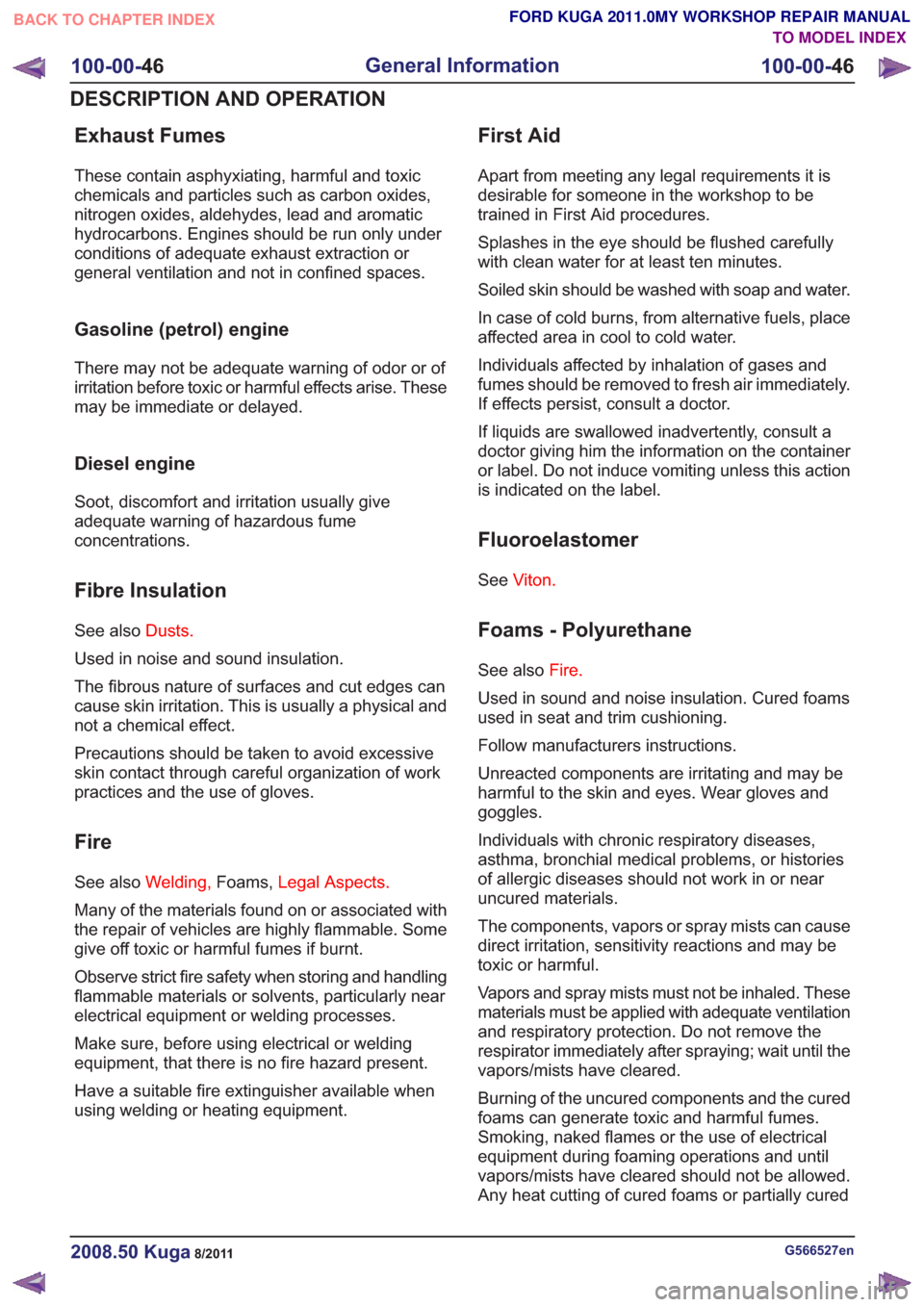
Exhaust Fumes
These contain asphyxiating, harmful and toxic
chemicals and particles such as carbon oxides,
nitrogen oxides, aldehydes, lead and aromatic
hydrocarbons. Engines should be run only under
conditions of adequate exhaust extraction or
general ventilation and not in confined spaces.
Gasoline (petrol) engine
There may not be adequate warning of odor or of
irritation before toxic or harmful effects arise. These
may be immediate or delayed.
Diesel engine
Soot, discomfort and irritation usually give
adequate warning of hazardous fume
concentrations.
Fibre Insulation
See alsoDusts.
Used in noise and sound insulation.
The fibrous nature of surfaces and cut edges can
cause skin irritation. This is usually a physical and
not a chemical effect.
Precautions should be taken to avoid excessive
skin contact through careful organization of work
practices and the use of gloves.
Fire
See also Welding,Foams,Legal Aspects.
Many of the materials found on or associated with
the repair of vehicles are highly flammable. Some
give off toxic or harmful fumes if burnt.
Observe strict fire safety when storing and handling
flammable materials or solvents, particularly near
electrical equipment or welding processes.
Make sure, before using electrical or welding
equipment, that there is no fire hazard present.
Have a suitable fire extinguisher available when
using welding or heating equipment.
First Aid
Apart from meeting any legal requirements it is
desirable for someone in the workshop to be
trained in First Aid procedures.
Splashes in the eye should be flushed carefully
with clean water for at least ten minutes.
Soiled skin should be washed with soap and water.
In case of cold burns, from alternative fuels, place
affected area in cool to cold water.
Individuals affected by inhalation of gases and
fumes should be removed to fresh air immediately.
If effects persist, consult a doctor.
If liquids are swallowed inadvertently, consult a
doctor giving him the information on the container
or label. Do not induce vomiting unless this action
is indicated on the label.
Fluoroelastomer
See Viton.
Foams - Polyurethane
See also Fire.
Used in sound and noise insulation. Cured foams
used in seat and trim cushioning.
Follow manufacturers instructions.
Unreacted components are irritating and may be
harmful to the skin and eyes. Wear gloves and
goggles.
Individuals with chronic respiratory diseases,
asthma, bronchial medical problems, or histories
of allergic diseases should not work in or near
uncured materials.
The components, vapors or spray mists can cause
direct irritation, sensitivity reactions and may be
toxic or harmful.
Vapors and spray mists must not be inhaled. These
materials must be applied with adequate ventilation
and respiratory protection. Do not remove the
respirator immediately after spraying; wait until the
vapors/mists have cleared.
Burning of the uncured components and the cured
foams can generate toxic and harmful fumes.
Smoking, naked flames or the use of electrical
equipment during foaming operations and until
vapors/mists have cleared should not be allowed.
Any heat cutting of cured foams or partially cured
G566527en2008.50 Kuga8/2011
100-00- 46
General Information
100-00- 46
DESCRIPTION AND OPERATION
TO MODEL INDEX
BACK TO CHAPTER INDEX
FORD KUGA 2011.0MY WORKSHOP REPAIR MANUAL
Page 52 of 2057
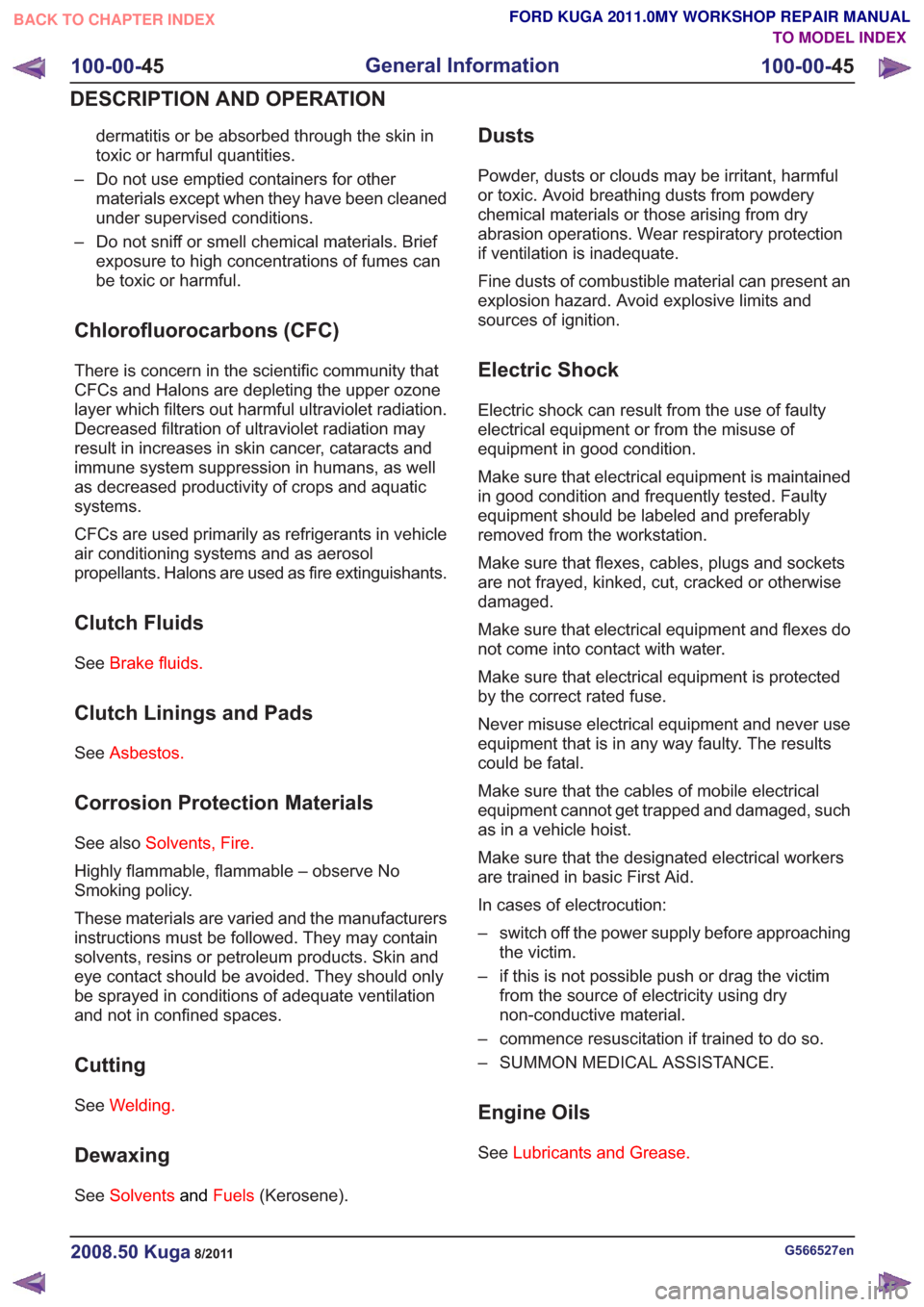
dermatitis or be absorbed through the skin in
toxic or harmful quantities.
– Do not use emptied containers for other materials except when they have been cleaned
under supervised conditions.
– Do not sniff or smell chemical materials. Brief exposure to high concentrations of fumes can
be toxic or harmful.
Chlorofluorocarbons (CFC)
There is concern in the scientific community that
CFCs and Halons are depleting the upper ozone
layer which filters out harmful ultraviolet radiation.
Decreased filtration of ultraviolet radiation may
result in increases in skin cancer, cataracts and
immune system suppression in humans, as well
as decreased productivity of crops and aquatic
systems.
CFCs are used primarily as refrigerants in vehicle
air conditioning systems and as aerosol
propellants. Halons are used as fire extinguishants.
Clutch Fluids
See Brake fluids.
Clutch Linings and Pads
SeeAsbestos.
Corrosion Protection Materials
See also Solvents, Fire.
Highly flammable, flammable – observe No
Smoking policy.
These materials are varied and the manufacturers
instructions must be followed. They may contain
solvents, resins or petroleum products. Skin and
eye contact should be avoided. They should only
be sprayed in conditions of adequate ventilation
and not in confined spaces.
Cutting
See Welding.
Dewaxing
SeeSolvents andFuels (Kerosene).
Dusts
Powder, dusts or clouds may be irritant, harmful
or toxic. Avoid breathing dusts from powdery
chemical materials or those arising from dry
abrasion operations. Wear respiratory protection
if ventilation is inadequate.
Fine dusts of combustible material can present an
explosion hazard. Avoid explosive limits and
sources of ignition.
Electric Shock
Electric shock can result from the use of faulty
electrical equipment or from the misuse of
equipment in good condition.
Make sure that electrical equipment is maintained
in good condition and frequently tested. Faulty
equipment should be labeled and preferably
removed from the workstation.
Make sure that flexes, cables, plugs and sockets
are not frayed, kinked, cut, cracked or otherwise
damaged.
Make sure that electrical equipment and flexes do
not come into contact with water.
Make sure that electrical equipment is protected
by the correct rated fuse.
Never misuse electrical equipment and never use
equipment that is in any way faulty. The results
could be fatal.
Make sure that the cables of mobile electrical
equipment cannot get trapped and damaged, such
as in a vehicle hoist.
Make sure that the designated electrical workers
are trained in basic First Aid.
In cases of electrocution:
– switch off the power supply before approaching
the victim.
– if this is not possible push or drag the victim from the source of electricity using dry
non-conductive material.
– commence resuscitation if trained to do so.
– SUMMON MEDICAL ASSISTANCE.
Engine Oils
See Lubricants and Grease.
G566527en2008.50 Kuga8/2011
100-00- 45
General Information
100-00- 45
DESCRIPTION AND OPERATION
TO MODEL INDEX
BACK TO CHAPTER INDEX
FORD KUGA 2011.0MY WORKSHOP REPAIR MANUAL
Page 56 of 2057
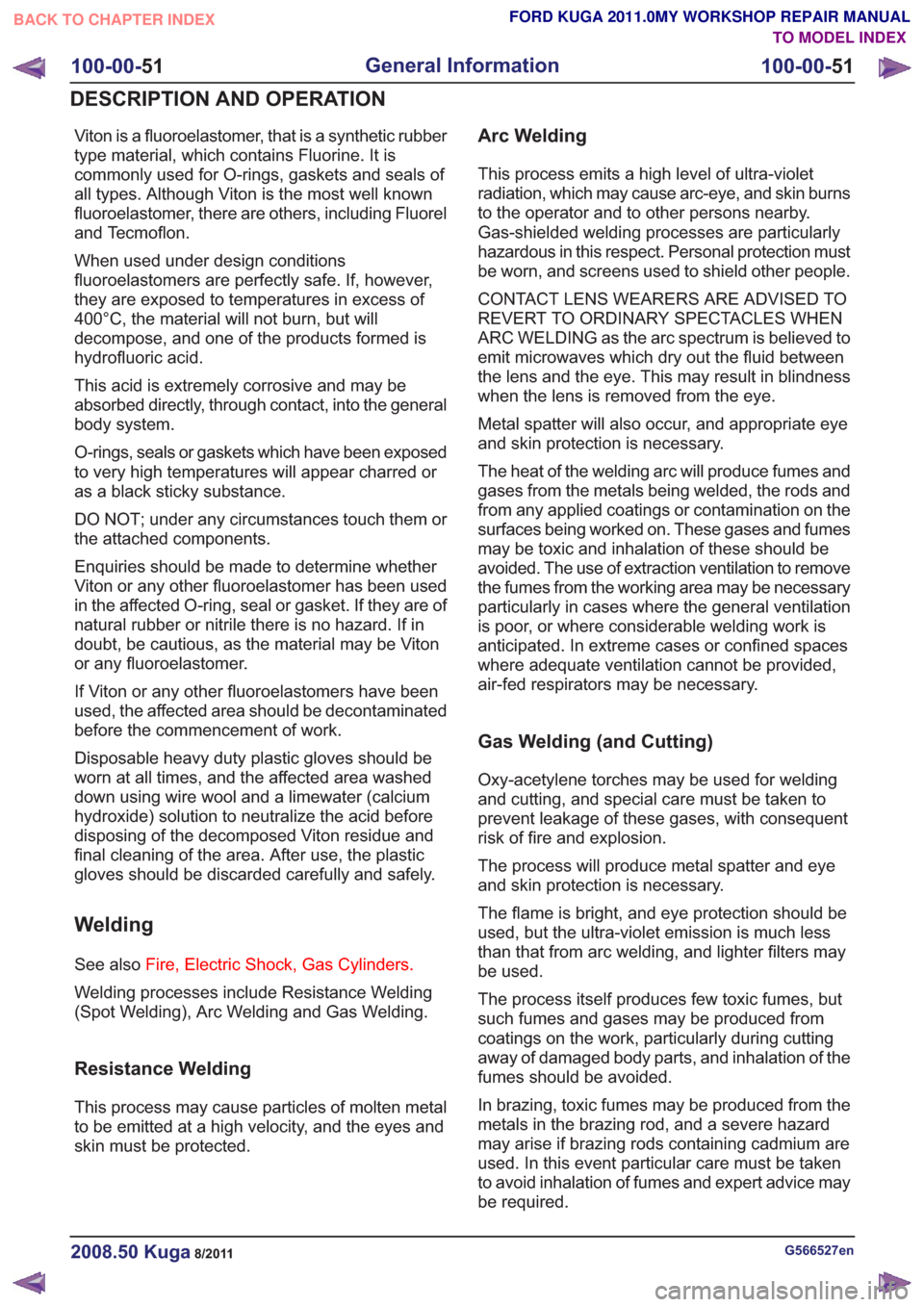
Viton is a fluoroelastomer, that is a synthetic rubber
type material, which contains Fluorine. It is
commonly used for O-rings, gaskets and seals of
all types. Although Viton is the most well known
fluoroelastomer, there are others, including Fluorel
and Tecmoflon.
When used under design conditions
fluoroelastomers are perfectly safe. If, however,
they are exposed to temperatures in excess of
400°C, the material will not burn, but will
decompose, and one of the products formed is
hydrofluoric acid.
This acid is extremely corrosive and may be
absorbed directly, through contact, into the general
body system.
O-rings, seals or gaskets which have been exposed
to very high temperatures will appear charred or
as a black sticky substance.
DO NOT; under any circumstances touch them or
the attached components.
Enquiries should be made to determine whether
Viton or any other fluoroelastomer has been used
in the affected O-ring, seal or gasket. If they are of
natural rubber or nitrile there is no hazard. If in
doubt, be cautious, as the material may be Viton
or any fluoroelastomer.
If Viton or any other fluoroelastomers have been
used, the affected area should be decontaminated
before the commencement of work.
Disposable heavy duty plastic gloves should be
worn at all times, and the affected area washed
down using wire wool and a limewater (calcium
hydroxide) solution to neutralize the acid before
disposing of the decomposed Viton residue and
final cleaning of the area. After use, the plastic
gloves should be discarded carefully and safely.
Welding
See alsoFire, Electric Shock, Gas Cylinders.
Welding processes include Resistance Welding
(Spot Welding), Arc Welding and Gas Welding.
Resistance Welding
This process may cause particles of molten metal
to be emitted at a high velocity, and the eyes and
skin must be protected.
Arc Welding
This process emits a high level of ultra-violet
radiation, which may cause arc-eye, and skin burns
to the operator and to other persons nearby.
Gas-shielded welding processes are particularly
hazardous in this respect. Personal protection must
be worn, and screens used to shield other people.
CONTACT LENS WEARERS ARE ADVISED TO
REVERT TO ORDINARY SPECTACLES WHEN
ARC WELDING as the arc spectrum is believed to
emit microwaves which dry out the fluid between
the lens and the eye. This may result in blindness
when the lens is removed from the eye.
Metal spatter will also occur, and appropriate eye
and skin protection is necessary.
The heat of the welding arc will produce fumes and
gases from the metals being welded, the rods and
from any applied coatings or contamination on the
surfaces being worked on. These gases and fumes
may be toxic and inhalation of these should be
avoided. The use of extraction ventilation to remove
the fumes from the working area may be necessary
particularly in cases where the general ventilation
is poor, or where considerable welding work is
anticipated. In extreme cases or confined spaces
where adequate ventilation cannot be provided,
air-fed respirators may be necessary.
Gas Welding (and Cutting)
Oxy-acetylene torches may be used for welding
and cutting, and special care must be taken to
prevent leakage of these gases, with consequent
risk of fire and explosion.
The process will produce metal spatter and eye
and skin protection is necessary.
The flame is bright, and eye protection should be
used, but the ultra-violet emission is much less
than that from arc welding, and lighter filters may
be used.
The process itself produces few toxic fumes, but
such fumes and gases may be produced from
coatings on the work, particularly during cutting
away of damaged body parts, and inhalation of the
fumes should be avoided.
In brazing, toxic fumes may be produced from the
metals in the brazing rod, and a severe hazard
may arise if brazing rods containing cadmium are
used. In this event particular care must be taken
to avoid inhalation of fumes and expert advice may
be required.
G566527en2008.50 Kuga8/2011
100-00- 51
General Information
100-00- 51
DESCRIPTION AND OPERATION
TO MODEL INDEX
BACK TO CHAPTER INDEX
FORD KUGA 2011.0MY WORKSHOP REPAIR MANUAL
Page 57 of 2057
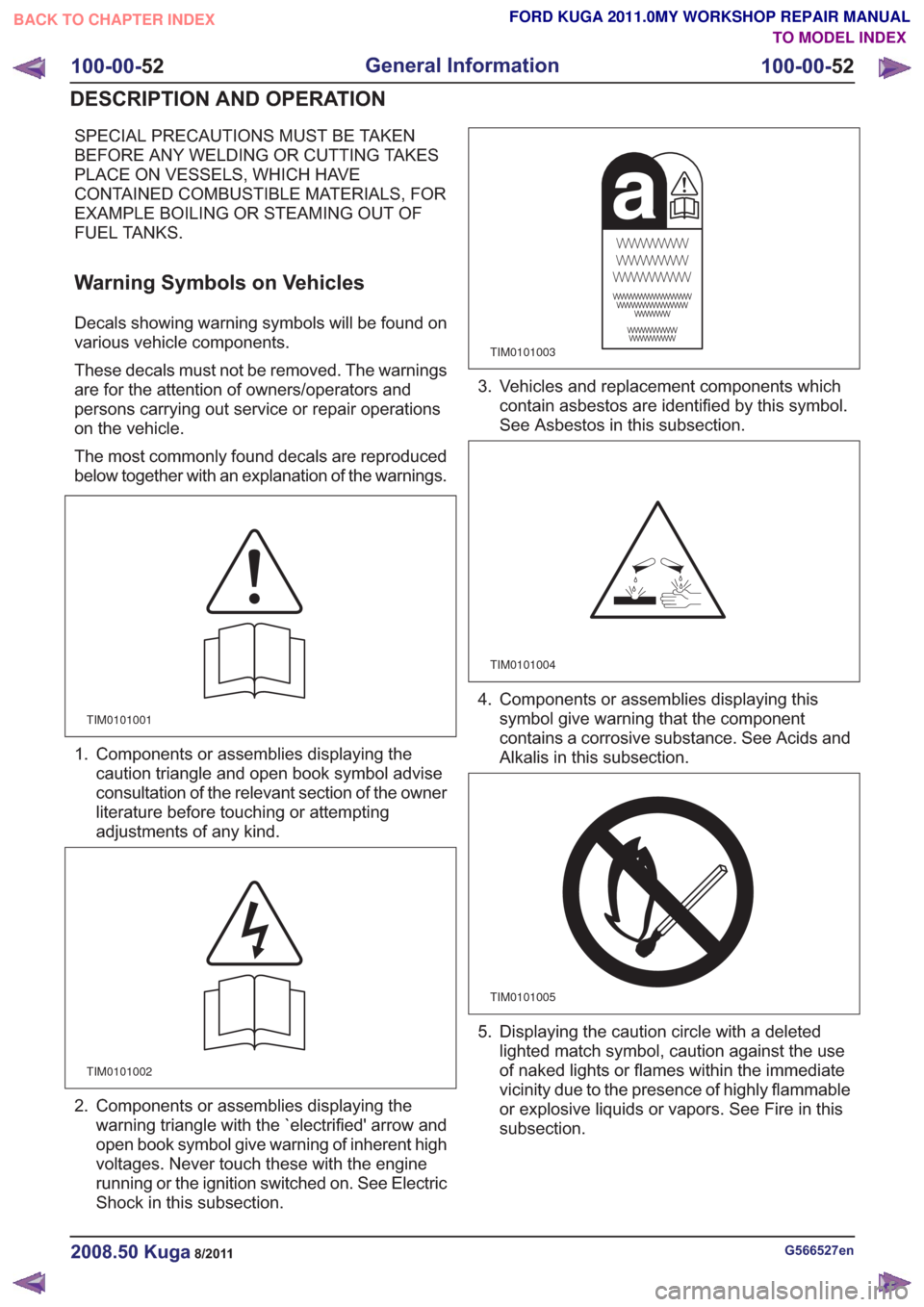
SPECIAL PRECAUTIONS MUST BE TAKEN
BEFORE ANY WELDING OR CUTTING TAKES
PLACE ON VESSELS, WHICH HAVE
CONTAINED COMBUSTIBLE MATERIALS, FOR
EXAMPLE BOILING OR STEAMING OUT OF
FUEL TANKS.
Warning Symbols on Vehicles
Decals showing warning symbols will be found on
various vehicle components.
These decals must not be removed. The warnings
are for the attention of owners/operators and
persons carrying out service or repair operations
on the vehicle.
The most commonly found decals are reproduced
below together with an explanation of the warnings.
TIM0101001
1. Components or assemblies displaying thecaution triangle and open book symbol advise
consultation of the relevant section of the owner
literature before touching or attempting
adjustments of any kind.
TIM0101002
2. Components or assemblies displaying thewarning triangle with the `electrified' arrow and
open book symbol give warning of inherent high
voltages. Never touch these with the engine
running or the ignition switched on. See Electric
Shock in this subsection.
TIM0101003
3. Vehicles and replacement components whichcontain asbestos are identified by this symbol.
See Asbestos in this subsection.
TIM0101004
4. Components or assemblies displaying thissymbol give warning that the component
contains a corrosive substance. See Acids and
Alkalis in this subsection.
TIM0101005
5. Displaying the caution circle with a deletedlighted match symbol, caution against the use
of naked lights or flames within the immediate
vicinity due to the presence of highly flammable
or explosive liquids or vapors. See Fire in this
subsection.
G566527en2008.50 Kuga8/2011
100-00- 52
General Information
100-00- 52
DESCRIPTION AND OPERATION
TO MODEL INDEX
BACK TO CHAPTER INDEX
FORD KUGA 2011.0MY WORKSHOP REPAIR MANUAL